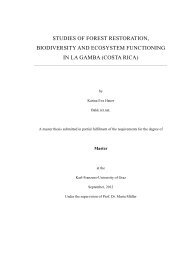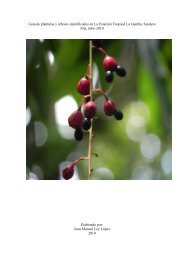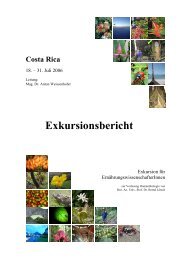Leaf colour patterns, vegetative and sexual reproduction of Episcia ...
Leaf colour patterns, vegetative and sexual reproduction of Episcia ...
Leaf colour patterns, vegetative and sexual reproduction of Episcia ...
You also want an ePaper? Increase the reach of your titles
YUMPU automatically turns print PDFs into web optimized ePapers that Google loves.
Anthesis<br />
The term “anthesis” describes the whole period in which a flower is active i.e. as long as<br />
pollen is presented <strong>and</strong>/or the stigma is receptive. The flowers <strong>of</strong> <strong>Episcia</strong> lilacina are prote<strong>and</strong>rous.<br />
Male <strong>and</strong> female stages proceed separately. This chapter deals with the process <strong>of</strong> <strong>Episcia</strong> lilacina’s<br />
anthesis.<br />
Materials <strong>and</strong> Methods: The process <strong>of</strong> anthesis was documented using the same plants<br />
<strong>and</strong> methods as in the last chapter. To assure the receptivity <strong>of</strong> the stigma, potassium<br />
permanganate (KMnO 4 ) was dissolved in water. This solution was transferred to the stigma,<br />
which in case <strong>of</strong> receptivity should turn black. Unfortunately the stigma turned black every time<br />
as soon as it came in contact with KMnO 4 . Receptivity was efficiently measured via observation<br />
because <strong>of</strong> the swelling <strong>of</strong> the stigma lobes.<br />
Results: The male stage (Fig. 27, left) <strong>of</strong> anthesis starts between four <strong>and</strong> five o’clock in the<br />
morning. Shortly after the opening <strong>of</strong> the flower the release <strong>of</strong> pollen begins. The four anthers<br />
open <strong>and</strong> the pollen is presented freely accessible.<br />
Between four <strong>and</strong> five o’clock in the afternoon the filaments coil. The stigma is still<br />
immature. The style has not reached its full length. Thus the male stage comes to an end. In the<br />
course <strong>of</strong> the next hours the style grows in length so that the stigma reaches the location that was<br />
held before by the anthers. During this growth the stigma becomes receptive. The female stage<br />
(Fig. 27, right) begins in the subsequent night between midnight <strong>and</strong> four a.m. <strong>and</strong> lasts one or<br />
two days. The end <strong>of</strong> the receptivity <strong>of</strong> style is signified by shrivelled stigma lobes. The corolla<br />
detaches itself <strong>and</strong> drops. The style stays prominent for a few days <strong>and</strong> withers afterwards. If a<br />
successful pollination took place a growth <strong>of</strong> fruit becomes recognizable after around three days.<br />
59
















